
'Death Gyre' in the Gulf - (with video)
Karl Burkart
June 10th was a strange day. In a surprising move, the Coast Guard instituted a dramatic expansion of the "no-fly" zone over the Gulf, preventing major media outlets like the New York Times and even scientists with top government clearance from accessing the area. This caused a wave of journalistic uproar and bewilderment on the part of researchers like Edward E. Clark of the Wildlife Center (above) who had been invited to study the impacts just prior to the media blackout.
More distressing than the media blackout itself was a lingering question in my mind ... what on earth could be so BAD that the U.S. government would risk losing credibility in the minds of journalists, the scientific community and the general public to ensure concealment? Was the sea floor cracking? Was a giant cloud of benzene going to wipe out the Eastern Seaboard? Had Godzilla emerged from the sea to wreak havoc upon us all? One thing was clear ... we weren't getting the story.
I have to write this mail on a new cellphone because they have taken our phones off us. people dont know how bad this oil is.. im working in the cleanup operation and we've all has to sign a legal paper that stops us from talking to anyone. im onshore now and cant tell you where but ive just finished a very long shift in the gulf and textin this....fast as i can. the military are watching us dolphins whales, seabirds fish are all floating dead on the surface of the water.. see more.. see more…boats helicopters are scooping them away dead and dying... Whales are being exploded by the military cause they cant be carried. dead bodys as far as the eye can see air smeling of benzene ..weve seen birds fall from the sky. workers falling sick we think some workers have died. my friends are hard oilmen it was ok to at the start but now we cry. dead sea life is as big as genocide you wont imagine
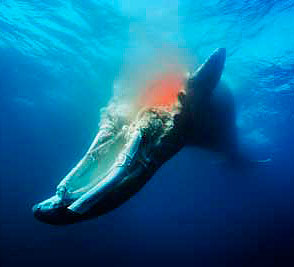 According to the latest count of the U.S. Fish and Wildlife Service's Daily Collection Report (PDF), only about 4,100 birds, 670 turtles, 70 sea mammals, and 1 snake have died in the Gulf since April 20 (assuming 50 percent mortality of live animals).
According to the latest count of the U.S. Fish and Wildlife Service's Daily Collection Report (PDF), only about 4,100 birds, 670 turtles, 70 sea mammals, and 1 snake have died in the Gulf since April 20 (assuming 50 percent mortality of live animals).
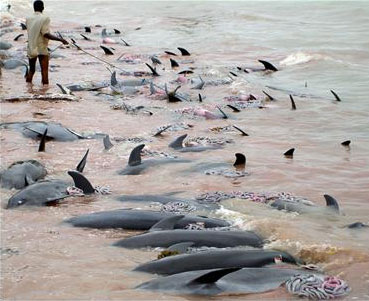 One would be forgiven then for assuming there should be a far greater body count than what is currently being reported by the Fish and Wildlife Service, the same government office that famously blocked Anderson Cooper from peering past the 10' high barricades that had been put up to enclose a "bird receiving" area. According to the math, the count should be in the hundreds of thousands of dead birds, tens of thousands of sea mammals, and millions upon millions of fish and shellfish. So where were all the dead bodies? We should be seeing something like the mass dolphin kill off the coast of Zanzibar (left) that resulted from a much smaller offshore oil leak.
One would be forgiven then for assuming there should be a far greater body count than what is currently being reported by the Fish and Wildlife Service, the same government office that famously blocked Anderson Cooper from peering past the 10' high barricades that had been put up to enclose a "bird receiving" area. According to the math, the count should be in the hundreds of thousands of dead birds, tens of thousands of sea mammals, and millions upon millions of fish and shellfish. So where were all the dead bodies? We should be seeing something like the mass dolphin kill off the coast of Zanzibar (left) that resulted from a much smaller offshore oil leak.... receiving unconfirmed confidential reports that BP is withholding information about fish kills including that of sperm whales, whale sharks, Blue-fin Tuna and other marine mammals. (…) Following up on these leads, recently I flew over the staging areas where the reports allege that BP has been engaged in these secretive operations. What I saw from the air over Shell Beach and Hopedale, Louisiana was what seemed to be military protected staging areas where whales could potentially be brought in from offshore, processed under huge white tents, then carted off in trash trucks owned by a collaborative of oil companies, including BP. I'm deeply concerned that BP has the power to put in place restrictions on... access to certain areas of the ever-growing BP drilling disaster location and will continue advocating for a change in this policy.
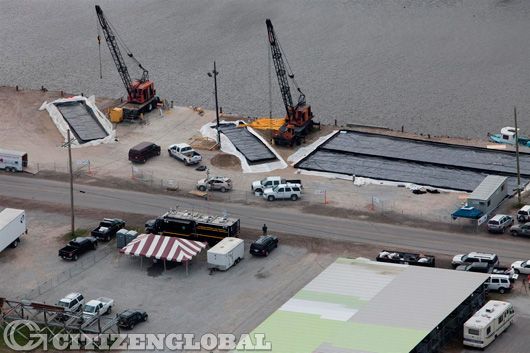
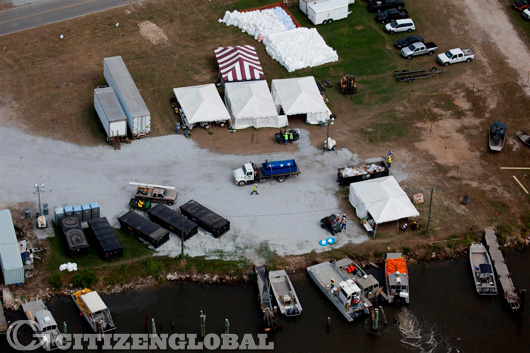
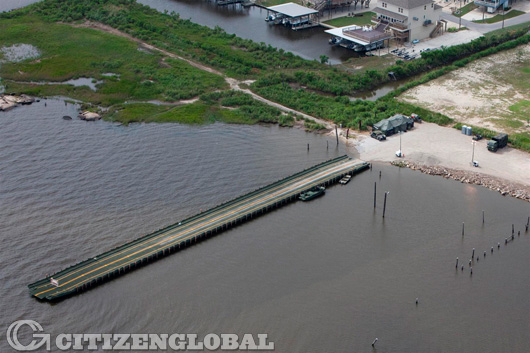
August 3, 2010
VIEW VIDEO
www.mnn.com/green-tech/research-innovations/blogs/death-gyre-in-the-gulf
